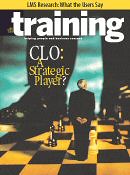Saturday, April 23, 2005
Old timers in the training biz remember the days before VNU and before Bill Communications, when Training the conference and Training the magazine were products of a small company named Lakewood Publications.

For a good while, Jack Gordon was editor of Training, which he invested with savvy and zest. Jack got the axe during some political intrigue. Tammy Galvin took the helm; Training magazine became so boring that I cancelled my subscription. About a year ago, Chris Lee took over and things are looking up. Jack Gordon is back as editor-at-large.
Jack cracks me up. In an editorial about management's perception of training, he writes, "While we're at it, here's one for top management: Does your training director find it difficult to make learning serve your desires because of the nature of your desires? If your idea of training that serves a critical need is a program that persuades employees to work more enthusiastically, for less money and fewer benefits, right up to the moment when you figrure out how to eliminate their jobs altogether, maybe the problem isn't your training director. Maybe what you really need is dumber employees."
I want to call your attention to Jack's article CLO: A Strategic Player? which flippantly and brilliantly describes the wrenching situation that keeps the training function hidden in the back room:

For a good while, Jack Gordon was editor of Training, which he invested with savvy and zest. Jack got the axe during some political intrigue. Tammy Galvin took the helm; Training magazine became so boring that I cancelled my subscription. About a year ago, Chris Lee took over and things are looking up. Jack Gordon is back as editor-at-large.
Jack cracks me up. In an editorial about management's perception of training, he writes, "While we're at it, here's one for top management: Does your training director find it difficult to make learning serve your desires because of the nature of your desires? If your idea of training that serves a critical need is a program that persuades employees to work more enthusiastically, for less money and fewer benefits, right up to the moment when you figrure out how to eliminate their jobs altogether, maybe the problem isn't your training director. Maybe what you really need is dumber employees."
I want to call your attention to Jack's article CLO: A Strategic Player? which flippantly and brilliantly describes the wrenching situation that keeps the training function hidden in the back room:
The vision must have sprung to life not long after the first corporate training departments crawled forth as distinct entities from the primeval ooze of the Industrial Age. It has been a theme on the conference circuit for as long as trainers have gathered in hotel ballrooms to discuss their careers. The vision is commonly expressed in the form of a sermon with a title like "Linking Training to Business Goals." A short version goes like this:Drat! I spent three or four hours today writing that same message (but using ten times as many words). I'm going to stash Jack's words to call up as shorthand instead of continuing to write about this over and over. If you followed a footnote to get here, use the back button on your browser to return to wherever you came from.
An organization's training unit should not operate in the form of a little red schoolhouse, tucked away in a corner, divorced from the vital strategic concerns of the business. It should measure its success not by the number of courses it runs or the number of people it runs through them, but rather by the impact of its efforts on critical business criteria. The training manager should not be the last to know about new initiatives or shifting priorities that will require employees to be brought up to speed. Instead, the top training person should sit in the executive meetings where those initiatives are born.
Furthermore, the top training person should have as much business expertise as educational savvy. He or she must understand what executives and line managers care about and why—by speaking to them regularly, in their language, about their concerns. Only then can training and performance-support efforts be linked to key goals and thus become a strategic driver of organizational performance. Without such a link, a training operation will always be seen as a cost center and a more-or-less necessary evil rather than as the priceless asset it ought to be.
Thus endeth the sermon.









0 Comments:
Post a Comment
<< Home